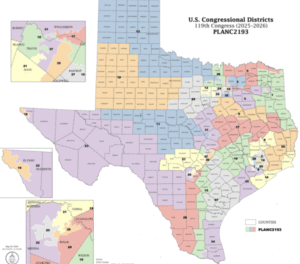Hakeem Jeffries Sounds the Alarm as GOP Expands Nationwide Redistricting Campaign Championed by Donald Trump

Across the United States, one of the most consequential political battles of the decade is unfolding — not through televised debates or campaign rallies, but through the quiet, highly technical process of redistricting. What was once a procedural task carried out once every ten years has now become a full-scale political arms race as Republican-led legislatures move aggressively to redraw congressional boundaries in multiple states.
And at the forefront of the Democratic resistance is House Minority Leader Hakeem Jeffries, who has emerged as the party’s most vocal critic of the GOP’s sweeping redistricting push.
Fueling this transformation is the influence of former President Donald Trump, who has urged Republican lawmakers to move quickly, capitalize on their state-level power, and reshape the congressional map ahead of the 2026 elections. According to GOP strategists aligned with Trump, the opportunity to secure long-term structural advantages will not last forever — a message that has accelerated redistricting efforts nationwide.
A Quiet Revolution in Redistricting
For decades, most states followed the standard rhythm: redraw district lines once per decade, immediately after the census. This prevented constant map manipulation and helped maintain political stability.
But that norm is collapsing.
With Trump pressing Republicans to “act now,” states that previously avoided mid-decade redistricting are reversing course. Legislatures are reopening the maps years before the next census count, initiating fresh lines that could alter congressional power for years.
Jeffries warns that this shift represents far more than a political disagreement — he sees it as a direct threat to democratic representation.

North Carolina: The New Epicenter
One of the most dramatic clashes erupted in North Carolina, where Republican lawmakers unveiled a newly crafted congressional map designed to secure an additional GOP seat. The proposal moved at lightning speed through the legislature, backed heavily by Trump’s inner circle and right-wing strategists.
Political analysts noted immediately that the map concentrated Democratic voters into a small number of districts — a classic “packing” technique — while distributing Republican voters across strategically drawn regions.
What made this case even more striking was the openness with which its designers acknowledged their goals.
Republican State Senator Ralph Hise, one of the leading architects of the proposal, bluntly stated that the map’s purpose was to guarantee Republicans “another congressional seat.”
Democrats erupted.
Jeffries condemned the plan as a direct example of using political machinery to predetermine election outcomes rather than allowing competitive elections to unfold naturally. In his view, North Carolina’s redesign was not an isolated incident — it was another data point in a national strategy aimed at reshaping Congress through redistricting rather than voter persuasion.
Public hearings in the state became tense. Protesters, community leaders, and civil rights groups argued that the new boundaries would weaken minority representation, divide urban communities, and silence political voices that have historically struggled to be heard.
Despite widespread public objections, the plan passed the state Senate and is expected to clear the Republican-dominated House. Because North Carolina law prevents Democratic Governor Josh Stein from vetoing redistricting measures, Republicans maintain nearly total control over the fate of the map.
To Jeffries, this lack of executive oversight is deeply concerning — and part of the reason he argues that democracy itself is “under assault.”

Texas: A Giant Stage for a High-Stakes Map Fight
If North Carolina is a flashpoint, Texas is a battlefield.
Republican lawmakers there have proposed a sweeping redistricting package that could create as many as five new GOP-leaning congressional districts, a move supporters argue reflects the state’s rapid population shifts.
Critics say the plan does the opposite — they argue it undermines the very communities responsible for that growth: diverse urban centers and fast-growing minority populations. Civil rights groups warn that by stretching and compressing certain regions, lawmakers are essentially siphoning power away from Democratic-leaning cities like Houston, Dallas, and Austin.
The proposal is expected to trigger numerous legal challenges, some of which are already being prepared.
Jeffries insists the Texas plan is another example of partisan engineering designed to entrench political power rather than represent voters fairly.
Missouri: Legal Challenges Mount
In Missouri, the legislature has approved a controversial new congressional map aimed at delivering Republicans an additional seat. However, the political victory may be short-lived. Multiple lawsuits have already been filed, and activist groups have launched petition drives to challenge the map on the ballot.
Jeffries points to Missouri as evidence of what he describes as a coordinated national strategy, arguing that Republicans are willing to gamble on extended legal battles to secure long-term political gains.

California: A Surprise Move in a Democratic Stronghold
Perhaps the most unexpected development has come from California, a state historically celebrated for its independent redistricting commission.
Governor Gavin Newsom, widely viewed as a likely 2028 presidential contender, is supporting a ballot measure that would temporarily suspend the commission’s authority and allow the Legislature to draw as many as five new Democratic-leaning districts. Supporters frame this as a necessary counterattack to Republican gains elsewhere.
Opponents — including some Democrats — argue that the proposal undermines California’s reputation for promoting fair districting and risks signaling that both parties are now embracing manipulation when convenient.
The referendum is set to go before voters in November, ensuring California’s redistricting battle will be one of the most closely watched in the nation.
Kansas, Indiana, Ohio, Utah: The Battle Expands
The redistricting fight is spreading across the Midwest and Mountain West.
Kansas
Lawmakers recently allocated nearly $500,000 to prepare for a special legislative session widely expected to target the district of Democratic Rep. Sharice Davids, one of the few Democrats in a deeply conservative state.
Indiana
Already holding a 7–2 congressional advantage, Republicans are exploring new ways to weaken another Democratic district — reportedly with direct support from the Trump White House. Vice President J.D. Vance has traveled to Indiana to meet lawmakers and reinforce the administration’s encouragement to proceed.
Ohio & Utah
Both states have been embroiled in redistricting disputes for years. New proposals are reigniting old battles, reopening legal conflicts, and injecting fresh uncertainty into electoral boundaries that remain unresolved.
Jeffries cites all these developments as clear signs of a national effort to manipulate congressional representation, warning that minority communities and urban voters could lose meaningful political influence.
Two Competing Narratives
The rhetorical divide between the two parties is deepening.
Democrats’ View — Led by Jeffries
Jeffries argues that redistricting has evolved from a technical necessity into a “political weapon” that undermines voter representation. He warns that unchallenged maps could lock in Republican congressional control for a decade, regardless of shifts in public opinion.
He emphasizes that democracy relies on competitive districts where voters — not mapmakers — determine outcomes.
Republicans’ Counterargument
Republicans insist they are acting entirely within legal authority. They argue that Democrats have historically redrawn maps to their own benefit when able, and point to California’s ballot proposal as proof that both parties engage in strategic redistricting.
From their perspective, every state is simply responding to demographic change and political reality.
The Stakes Could Not Be Higher
Political observers agree that these redistricting battles may shape the 2026 midterms more than campaign spending or candidate quality.
Why?
Because the drawing of districts determines:
-
Which communities have influence
-
Which party holds structural advantage
-
Which candidates are viable
-
How closely seats align with statewide vote totals
And perhaps most importantly:
Who controls Congress for the next decade.
Public trust in the system is also on the line. Advocates warn that when citizens feel their votes carry less weight due to the shape of a district, faith in democracy erodes.
To Jeffries, this is not simply a partisan fight — it’s a defense of the electoral system itself.
A Long Battle Ahead
Both Republicans and Democrats believe they are protecting democracy. Both believe they are responding to national shifts. And both sides are preparing for a prolonged fight involving:
-
state legislatures
-
federal courts
-
advocacy groups
-
commissions
-
governors
-
and national party leaders
As new maps emerge, legal challenges multiply, and public protests intensify, one thing is clear: the redistricting wars are far from over.
The map of the United States is being redrawn — not only on paper, but in ways that could redefine American politics for a generation.
And the outcome will echo far beyond state boundaries. It will influence national policy, determine political power, and shape the future direction of the country.
The battle has begun. The consequences will be enormous. And the story is still unfolding.